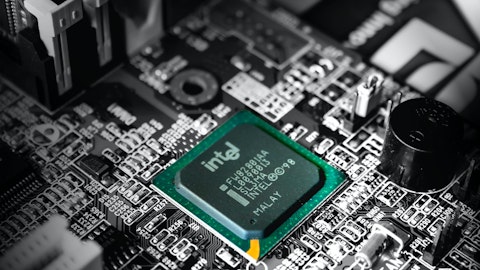Onto Innovation Inc. (NYSE:ONTO) Q4 2023 Earnings Call Transcript February 8, 2024
Onto Innovation Inc. beats earnings expectations. Reported EPS is $1.06, expectations were $0.99. ONTO isn’t one of the 30 most popular stocks among hedge funds at the end of the third quarter (see the details here).
Operator: Good day and welcome to the Onto Innovation Fourth Quarter and Full-Year Earnings Release Conference Call. Today’s conference is being recorded. At this time, I would like to turn the conference over to Mike Sheaffer, Investor Relations. Please go ahead.
Mike Sheaffer: Thank you, Rachel, and good afternoon, everyone. Onto Innovation issued its 2023 fourth quarter and full-year financial results this afternoon shortly after the market closed. If you did not receive a copy of the release, please refer to the company’s Web site, where a copy of the release is posted. Joining us on the call today are Michael Plisinski, Chief Executive Officer; and Mark Slicer, Chief Financial Officer. I would like to remind you that the statements made by management on this call will contain forward-looking statements within the meaning of the federal securities laws. Those statements are subject to a range of changes, risks and uncertainties that can cause actual results to vary materially. For more information regarding the risk factors that impact Onto Innovation’s results, I would encourage you to review our earnings release and our SEC filings.
Onto Innovation does not undertake the obligation to update these forward-looking statements in light of new information or future events. Today’s discussion of our financial results will be presented on a non-GAAP financial basis, unless otherwise specified. As a reminder, a detailed reconciliation between GAAP and non-GAAP results can be found in today’s earnings release. I will now go ahead and turn the call over to our CEO, Mike Plisinski. Mike?
Michael Plisinski: Thank you, Mike. Good afternoon, everyone, and thank you for joining our call today. As you may have already seen, Onto Innovation had a strong end to the year, with fourth quarter revenues exceeding the high end of our guidance range. This was primarily due to stronger-than-projected demand for Dragonfly inspection systems to support packaging of memory and logic devices for AI applications. We expect this demand to continue, as reflected in our increased guidance range for the first quarter. Financially, we’re starting to benefit from tighter controls and operational efficiencies, which resulted in generating over 28% of cash from operations in the quarter, while still supporting the multi-quarter surge in demand for the Dragonfly systems.
We expect improvements in margins will soon follow, bringing us back in line with our long-term operating model by end of the year. So, let’s begin with our specialty and advanced packaging customers, where the boom in AI spending lifted revenue from this market by 17% over the prior quarter, and set a consecutive quarterly record. In fact, since the start of the year, quarterly revenue for the specialty device and advanced packaging markets has grown 65%, while on an annual basis revenues have risen from $220 million, in 2020, to just over $500 million in 2023. Several markets have contributed to this growth, including power semiconductors, where demand for our solutions increased 50% this year. But the greatest and most consistent growth has come from our long-standing partnerships with the top semiconductor manufacturers and their increasing investments in advanced packaging, including chiplet and 3D memory architectures.
Over the next several years, as these architectures increase in complexity and interconnect density, we expect additional process steps to create the need for more Dragonfly inspection and new metrology applications. For example, in the fourth quarter, we shipped several of our newer front-end metrology systems, including Echo films and aspect metrology to leading manufacturers and OSATs for emerging packaging applications. Another highlight for the quarter was our lithography team shipping three systems, as planned, to two customers supporting mobile and high-performance compute applications. To complement our lithography tools and provide additional technology for leading-edge panel manufacturers, we announced the availability of our latest Firefly G3 panel inspection system in the fourth quarter.
This third generation of our Firefly panel tool now includes all of the metrology capabilities of the Dragonfly G3, and shares the same high-performance optical design. This tool’s inspection and metrology capability is being used to qualify glass panel substrates, as well as more traditional panels. It is fully integrated with our software solutions, which we expect will help our customers accelerate their ability to reach productivity and yield targets, especially for the next generation of heterogeneous packaging technologies. Turning briefly to the advanced nodes, as we projected, revenue from these customers declined in the fourth quarter. And we believe it has finally reached the bottom. Consistent with historical performance, the revenue was split nearly equally between DRAM, NAND, and logic.
Although revenue was light overall, we continue to receive early orders for gate-all-around pilot lines. And in the fourth quarter, we received approximately $20 million of additional orders for Atlas and Iris systems for deliveries in the first-half of 2024. We’re optimistic that these placements indicate a strengthening of our position, when volumes ramps occur, likely in early 2025. Now, I will turn the call over to Mark to discuss our financial performance in the fourth quarter, and guidance for the first quarter.

Mark Slicer: Thanks, Mike, and good afternoon, everyone. As Mike highlighted, we closed the fourth quarter with revenue of $219 million, up 6% versus the third, and a revenue milestone for us in 2023, exceeding our guidance range while achieving a high mark for revenue within the year. Fourth quarter EPS increased 10% sequentially to $1.06, exceeding the midpoint of our guidance but constrained by the decline in our high-margin advanced nodes business and lower services parts revenue within the quarter. Looking at the quarterly revenue by markets, advanced nodes, which had revenue of $18 million, declined 30% over Q3, and represents 8% of revenue. Specialty device and advanced packaging, with record revenue of $158 million, increased 17% over Q3, and represents 72% of revenue.
Software and services, with revenue of $42 million, declined 8% over Q3, while representing 20% of revenue. Fourth quarter operating expenses were $56 million, at the low end of our guidance range of $56 million to $58 million. We continue to actively manage costs while realizing the benefits of our cost reduction initiatives put in place earlier in the year, and driving our OpEx run rate back to Q4 ’21 levels. Our operating income, of $56 million, was 26% of revenue for the fourth quarter, compared to 24% for the third quarter. Our net income for the fourth quarter was $52 million, 24% of revenue versus 23% for the third quarter. Both operating income and net income performance versus the third quarter highlight our improving operating leverage within the year.
Now moving to the balance sheet, we ended the fourth quarter with cash and short-term investments of $698 million, an increase of $150 million from the beginning of the year, with operating cash flow of $62 million within the quarter, representing 28% of revenue and achieving a quarterly record for operating cash flow. Inventory ended the quarter at $328 million, a decrease of $18 million from Q3, representing a 14% reduction of our days inventory outstanding. Even with ramping Dragonfly production requiring us to procure long lead time items, we do expect further reduction in inventory days outstanding as inventory optimization remains a critical working capital focus area to drive consistent cash flow performance exceeding 20% of revenue.
Accounts receivable increased $17 million to $227 million in the quarter, and our days sales outstanding increased two days to 94 days. Now turning to our outlook for Q1, we currently expect our revenue for the first quarter to be between $215 million and $230 million. We expect gross margins will be between 51% to 53% as we continue to experience historical lows in the advanced nodes business, and only the initial phases of our supply chain reductions taking hold in the quarter. For operating expenses, we expect to be between $58 million to $60 million, higher versus Q4 primarily due to annual reset of payroll taxes and other compensation components. For the full-year ’24, we expect our effective tax rate to be between 14% to 16%, which does not assume any impact for potential tax legislative changes that may occur during the year.
We expect our diluted share count for Q1 to be approximately 49.8 million shares. Based on these assumptions, we anticipate our non-GAAP earnings for the first quarter to be between $1.00 per share to $1.20 per share. Looking forward to 2024, critical focus area for us continues to be our targeted programs for operating improvements necessary to return to our operating model. And with that, I will turn it back to Mike for additional insights into Q1, and 2024. Mike?
Michael Plisinski: Thank you, Mark. Our guidance range for the first quarter reflects continued strong demand for our Dragonfly inspection systems to support increases in AI device production. By way of comparison, our inspection business in the first quarter is expected to be three times larger than Q1 of last year before the generative AI and LLM started to hit the market. In contrast, advanced node spending is still at historical lows, but we do expect advanced node revenue to pick up a bit in the first quarter, and gain some strength through the year. Broadly speaking, we see advanced packaging, especially for the leading-edge AI devices, will be a healthy multiyear driver for our business. We’re encouraged by the recent comments from TSMC during their earnings call, in which they are forecasting a 50% CAGR through 2027 for their AI application processors.
In addition, they also are forecasting greatly increased silicon content for networking and edge devices that will begin adding neural processing in phones and PCs. Gartner provided a similar outlook with their expectation that AI semiconductor revenues forecast to be about $140 billion by 2027, a more subdued 27% CAGR. What we find exciting is that, in addition to the growth rate for AI devices, we expect an increase in capital intensity of process control for those devices as manufacturers increase stacks of DRAM, implement denser and smaller interconnects, and include a greater number of chiplets per package. The increase in complexity will require greater emphasis on the interconnect quality and the number of steps will increase with layers and complexity.
But continuing our partnerships with leaders in this market, we’re developing the technologies they require to maintain their pace of innovation and meet production yield targets. We’re only in the dawn of the AI era, and the outlook is very exciting. We expect AI packaging to be a strong driver for 2024, with our backlog already extending into the second-half of the year. However, the timing and magnitude of the recovery in advanced nodes remains uncertain even as we see took utilizations improving and incremental technology buys increasing. Based on the strength of our AI packaging business and gradual recovery in the advanced nodes, we project low double-digit growth for the year. With that, Rachel, we’ll open the call to your questions.
Rachel?
See also 15 Most Powerful Asian Countries in 2024 and 15 Highest Quality Essential Oil Brands in the World.
Q&A Session
Follow Onto Innovation Inc. (NYSE:ONTO)
Follow Onto Innovation Inc. (NYSE:ONTO)
Receive real-time insider trading and news alerts
Operator: Thank you. [Operator Instructions] Our first question comes from Vedvati Shrotre with Jefferies.
Vedvati Shrotre: Hi. Thanks for taking my question. The first one is, so last couple of quarters you’ve talked about multiple orders, I think going to $230 million for your packaging revenue. Could you talk about the order momentum you’re seeing, is that kind of the trajectory that you — that continues as we go into next quarter?
Michael Plisinski: Going into the next [multiple speakers], so the backlog is there to — yes, so going into the next two quarters, we’ll be strong, and reflected in the increase in our guidance. Second-half, as we mentioned, we’ve got some backlog that extends all the way through the second-half, not at the same level, but it’s still early and we’ll see where our customers start to increase as they come out of Chinese — Lunar New Year.
Vedvati Shrotre: Right. And for my second — if I may ask a follow-up, so you talked about the front-end metrology tools starting to get used in packaging application. Could you compare and contrast what kind of use cases there are for front-end tools versus what Dragonfly did on the inspection side?
Michael Plisinski: It’s different types of metrologies and more complex. So, in some cases, we could be looking for voids in metals or we’re looking for metal thicknesses that the Dragonfly doesn’t do as well as the Echo product line does. And there’s different applications for that whether you’re looking at TSVs or bump — the creation of — the metal stacking of bumps and bond pads, things like that. There are some other applications as well, but that gives you an idea.
Vedvati Shrotre: All right, that’s helpful. Thank you.
Operator: Your next question comes from the line of Craig Ellis with B. Riley Securities.
Craig Ellis: Yes, thanks for taking my question. Mike, I wanted to start with a couple with you, one, great to see the strength in advanced packaging and Dragonfly. The question is this, given how robustly that business has ramped, up 3x year-over-year, can you talk about some of the manufacturing and fulfillment issues, how are you doing on capacity, any constraints, et cetera, as you look to meet demand that exists through your first quarter guidance, and then just the further momentum in the second quarter?
Michael Plisinski: That’s a good question, and it’s a good concern. But I’m actually very impressed with our team. They’ve done a great job working with our suppliers, working internally, moving resources from one factory to another, for instance from California to Minnesota in order to ensure that we are able to meet the ramp with the level of quality that customers expect from us, and even increase it again. So, we talked about at Q4, we’re increasing the capacity again for the first-half of the year as well. So, so far the team’s done an outstanding job working through everything, and we don’t see — we’re overcoming every hiccup that we see.
Craig Ellis: Yes, got it. Okay, good to hear. And then, secondly, you did mention that you expect some pretty modest advance nodes pickup in the first-half of the year and that to accelerate. Can you talk about which end use areas are the first to see increased tool shipment activity? And how would you expect the other end use areas to lay around as you go through the second-half and into next year?
Michael Plisinski: Yes, I think it’s mostly of logic, and then followed by DRAM. And again, these are incremental improvements. I think there’s still — as I mentioned, still a lot of uncertainties, when we’ll see real volumes picking up; maybe in the second-half or maybe into early next year. But we’re definitely seeing some incremental improvements. We’ve even seen some incremental improvements in NAND, but that’ll be a little bit further out.
Craig Ellis: Sure. And then, if I could just sneak one in for Mark. Mark, nice to hear that the efficiency enhancements are benefiting things like cash generation, with record operating cash flow. The question is on the impact to gross margin. You indicated you expect to be back in the target model by the end of the year. What’s the contour for getting there? Is it fairly linear from here or is it really more back-end loaded with a little help from advanced nodes? Thank you.
Mark Slicer: Yes, Craig, certainly as we look at the model for the year, our goal is certainly to show quarter-over-quarter improvement in gross margin. It really comes down to just executing similar to what we did with operating expenses and working capital management, just executing what we have in place right now for supplier management, price — commodity pricing, and executing the supply chain initiatives that we have. It does certainly help to have advanced nodes back in the area of where it was previously. I mean that is our, historically, higher margin business. But again, there’s a lot of things in our control from a cost perspective that we still need to get moving in the year to continue to show that improvement.
Craig Ellis: Got it. Thanks, guys.
Operator: Your next question comes from the line of Brian Chin with Stifel.
Brian Chin: Hi there. Good afternoon, and thanks for letting us ask a few questions. Maybe Mike, where have you managed to keep lead times on the Dragonfly given the demand and your ability to stay in front of it? And more broadly, when talking to customers, what are your discussions around second-half capacity needs for AI packaging? And should we really think about second-half expansion being a function of expectations for growth in the AI market in 2025? Is that kind of the right way to think about that?



